Day 6: The Inca ruins around the city of Cuzco
This day's itinerary was made up of the four Inca sites outside Cusco,
plus the Coricancha and the cathedral within Cusco itself. We started by driving out
of the city to the Inca site of Tambomachay, known for its ceremonial stone baths of the
Inca. It wasn't a large site (the photo below pretty much sums it up), but its clever
plumbing system and nice stonemasonry were very interesting. I bought a stone chimu
(ceremonial Inca curved knife) from one of the local vendors at the entrance to the site,
and tasted a freshly cooked potato (one of the hundreds of local potato varieties) that
was offered to us by a Quechua woman. I offered to pay for the potato, but our guide said
that it was not necessary, as the potato was a gift. I gave the woman a colored pen, which
she appreciated.
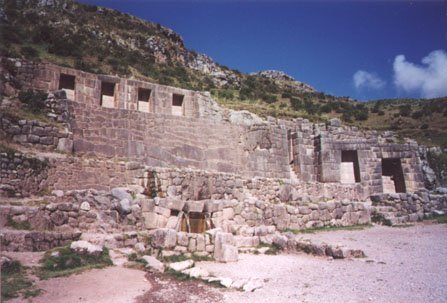
The site of Tambomachay, with its sacred running water. The
bottom wall has a darker area where water can be seen coming out in two spouts (a similar
spout is in the wall one level higher). This water travels through an underground section
(under the flat ground in the right foreground), emerging on the other site of the
courtyard, where it travels across a niched log over a ditch before disappearing somewhere
beyond. The large niches in the walls are at least six feet tall, and used to hold Inca
mummies or other sacred objects.
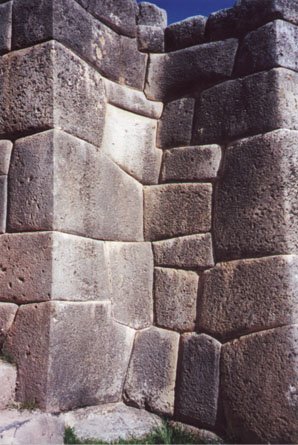
This is a close-up of a corner section of the wall shown in the
previous photo. It is just to the right of the stairway break in the wall, and just to the
left of the second-from-the-left large trapezoidal niche in that wall. (See the one
whitened stone as a reference point.) Note how this bend in the wall is a curved
inner corner, not a right angle as you would expect. Despite the odd shapes of the stones
(curves and all), they fit together perfectly, with no space in any of the junctures.
Puca Pucara was the second site, on the other side of the main road near
Tambomachay. It was supposedly a small fortress, made with a number of reddish stones (the
name literally means "red fort"). However, to me it looked just as grey as every
other Inca ruin we saw. It was not very spectacular, but since it was right next to
Tambomachay, it was worth a few minutes of time to visit it.
The third site was Qenko (also called Qenqo, Kenko, Qenco, etc.). Qenko is
mostly made up of one incredibly large limestone rock, which is covered with symbolic
carvings, and contains a number of tunnels and an unusual cave that has been carved out of
the rock. It must have taken a massive amount of work to cut this cave directly out of the
solid rock.
I expected us to go to the fourth site, Sacsayhuaman, next, but instead we
went back into Cusco so that we could tour the Coricancha and have lunch.
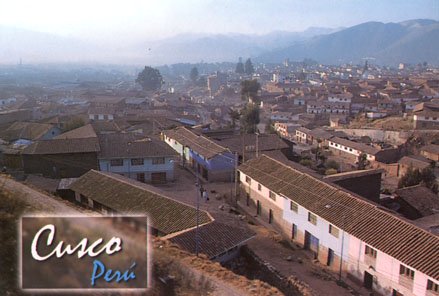
This is a postcard overview of Cusco. The red tile roofs are a
legacy of the city's Spanish colonial heritage, though there still exists many places in
the city where the walls or bases of buildings are constructed with remarkable Inca
stonework, using close-fitting stones in a patchwork pattern.
Back in Cusco, we visited the cathedral in the main plaza ("La
Catedral en la Plaza de Armas"). I'm not particularly interested in churches,
cathedrals, and the like, but it was evidently a common tourist stop. There was no cameras
or filming allowed inside, but there wasn't much I would have taken pictures of anyway.
Granted, there were some impressive displays of Christian art, statues, etc., but the
excess of gold and silver only served to remind me of the conquistador's rape of the Inca
empire, which is a sore spot with me. Also of momentary interest in the cathedral was the
famous large painting of the Last Supper, which shows a roast guinea pig (an Inca
delicacy) as the main course.
Probably one of the most famous of the old buildings in Cusco was the
church of Santo Domingo, which was built over the site of the Inca's most sacred temple,
the Coricancha. A large section of the original Inca curved wall can still be seen below
the church on the outside, and the walls of a few small Inca temples still exist within
the church grounds. The stonework on these walls (especially the interior temples) is
excellent, and is definitely worth the visit if you are interested in Inca stonemasonry
techniques. The Spanish church has actually been destroyed twice and damaged again in
1986, while the Inca walls have remained relatively untouched.
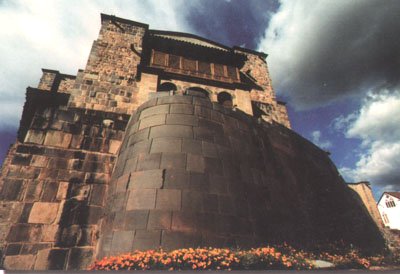
A postcard showing the exterior of the Coricancha, the site of
the sacred Inca temple that was replaced by a Spanish church. The curved gray stone wall
in the center foreground is the remainder of the Inca temple that was left behind (and
built on top of) by the Spanish.
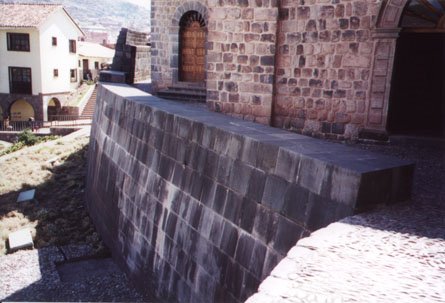
This is a view from up on top of the curved Inca wall, taken
from the spot on the far left of the above photo. You can see the difference between the
Spanish method of wall construction (using irregular stones fixed in mortar), versus the
Inca technique of using perfectly fit stones that required no mortar.
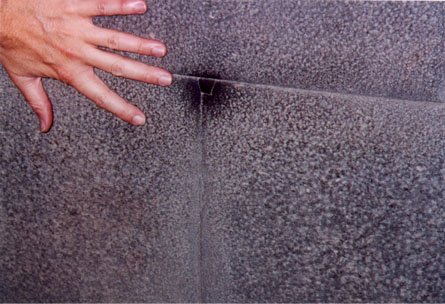
Inside the church grounds are the standing walls of some of the
original Inca interior temples. You can see the perfect fit of the stones in the photo
above. The important part of this photo, though, is the apparently tiny stone that is the
size of my thumbnail (it and the surrounding area have been blackened over decades of
being touched by the fingers of tour guides). This tiny stone was used to fill a small
hole between the large blocks, but what makes it remarkable is that it maintains its exact
trapezoidal shape all the way through to the other side of the wall, over two feet away!
Incredible.
Once we were done at the Coricancha, we were finally taken to the final
Inca ruins for the day, the famous Inca fortress of Sacsahuaman. Some people believe that
the old Inca capital of Cusco was laid out in the shape of a puma's body, and that the
zig-zag walls of Sacsahuaman represented the teeth in the jaws of the puma. As a defensive
fortress it must have been very impressive in its time, and even with most of the stones
gone it is still impressive today. The walls of Sacsahuaman are known for containing huge
rocks that seem to large to move by any ancient methods, as well as for containing rocks
that have a large number of angled or curved corners. These corners fit exactly into the
other odd-shaped rocks that surround them, and due to being a variety of unusual shapes
and perfectly fit, they have survived countless earthquakes over the ages. It doesn't take
much of an imagination to think that long after modern civilization has fallen and all the
skyscrapers have turned into rubble, these massive walls will still be here, unchanged.
Many people marvel at how the Incas cut and fitted their stones so
precisely. The PBS series "Nova" had an interesting episode on the subject,
though I wasn't convinced by their conclusions. Personally I think that there was more to
it than just repeatedly hitting stones to chip away minute pieces until the two sections
matched exactly. There are some quarries in South America where it looks like the stones
were removed from the bedrock using lasers, leaving perfectly flat right angles behind.
While I don't believe they used lasers, the perfect cuts (like a hot knife through cold
butter) are not only unnecessary, but beg the questions "How?" and
"Why?" Another aspect that interests me was a story that I read in a book I once
had. It related the tale that archeologists in South America once found some ancient pots
in a cave, and upon retrieving them accidently dropped one to the ground, where it broke
upon and the liquid inside spilled upon the ground. The scientists noted that where the
liquid lay on the bedrock, the rock became softened and malleable. The softened rock later
re-hardened to its original hardness. It was postulated that ancient peoples had found a
formula using a certain plant extract that caused rock to temporarily soften so that it
could be worked into other shapes. Perhaps this might explain some of the excellent
stonework of ancient cultures, where stones were fitted so closely together that even a
piece of paper cannot be put between them. If two stones were reasonably dressed
(smoothed), then both sides were treated with this softening agent, the stones could be
put together so that when they re-hardened there would be no gaps between them. If you
think that sounds too wild to be true, click HERE to check out some
scientific papers on a related topic at the Geopolymer Library.

A cropped photo from our panoramic camera of the three levels of
long wall sections at Sacsahuaman. This Inca fortress was mostly dismantled by the
Spaniards, who hauled the stones away to Cusco for construction purposes. Only the
heaviest stones at the base of the walls remained, too large for the Spanish to move (how
the Inca did it in the first place is still somewhat of a mystery). So when you look at
the walls above, what you are seeing is only the bottom third of the original walls. When
you realize the original size of this fortress it is impossible not to be impressed.
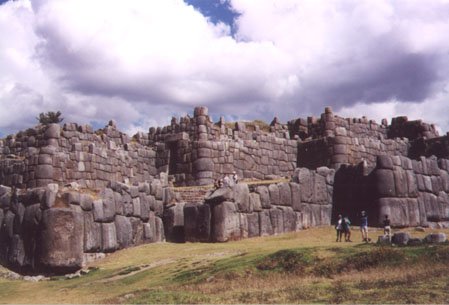
A close-up photo of the center section of the walls.
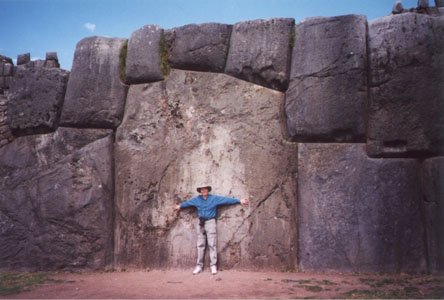
Here I am providing a sense of scale to one section of the wall,
standing against one particularly large stone. This stone was massive, and thick, weighing
many tons. It had multiple corners, fitted exactly against the stones that surrounded it.
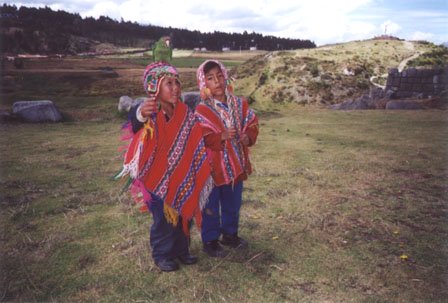
Another example of local indians dressing up in colorful
traditional Inca costumes in order to pose for tourist cameras in exchange for coins.
These kids are using a green parrot (sitting on the left one's head) as the "cute
animal du jour".
Having completed our official tour for the day, we returned once more to
Cusco. Upon our guide's recommendation, we returned to the Plaza del Armas to go to have
lunch in one of the many restaurants there, called Los Portales. It was crammed into a
small area, going up three floors, requiring dexterity to climb the incredibly narrow
circular staircase to get to the top floor. (It would have been a
lawsuit-waiting-to-happen if it had been in the U.S.) We ate on the balcony,
watching the goings-on in the plaza. The food was decent, though their version of a
Canadian bacon and pineapple pizza (which included cherries) was a little unusual.
After lunch set off to go see some more sights before they closed for the
day. We went to two museums, with the better of the two being the Inka Museum, which was
not far from the central Plaza, and only a block or so from the hotel. It was probably the
best museum in Cusco for Inca-related exhibits, though they did not allow photographs or
videos to be taken. As I did on a number of occasions on this trip, I got around this rule
by holding my camcorder flat in my hand at waist level, running in record mode. I had
previously turned off the feature that made the red light go on while recording, and
merely turned my body in the direction of whatever it was that I wanted to film. Since I
didn't have the camera up to my eye, the guards would assume I wasn't filming. While I
wasn't able to see the viewfinder (resulting in some very rough filming), it usually got
the job done. This crude method of filming was only good for the home video version of the
trip for Sue or myself, but that was fine, as we just wanted to remember what we had seen.
It also came in handy when filming some of the local peoples on our trip, since they
didn't know that they were being filmed. I have also used this technique on other trips
when I was climbing a pyramid or trekking a perilous path, so that I could re-live the
experience later, while still keeping my eyes on what I was trying to do at that
particular moment.
We finished up at the museum before they closed, and returned to the hotel
to freshen up and rest before dinner. While the day's activities weren't really strenuous,
it was easy to get worn down because of the high altitude. Back in the room I used the
rest period to sort through and label the variety of small rocks that I had picked up
during the day (it is a tradition of ours to pick up a small 1 inch rock from every
ancient site that we went to). After checking our purchases and growing post card
collection, we went back to the plaza, where we ran the usual gauntlet of tourists,
beggars, souvenir sellers, and restaurant employees who thrust their menus at you and
tried to get you to go to their nearby restaurant. I changed some traveller's checks at
one of the many money change shops in the plaza, and we headed straight to the Inka Grill,
which our guide had recommended to us. Dinner was good, though we were annoyed by the
cigarette smoke from some nearby Europeans. You get spoiled in the U.S. having smoke-free
restaurants, and it's hard to get used to returning to the "Old World" way of
living.